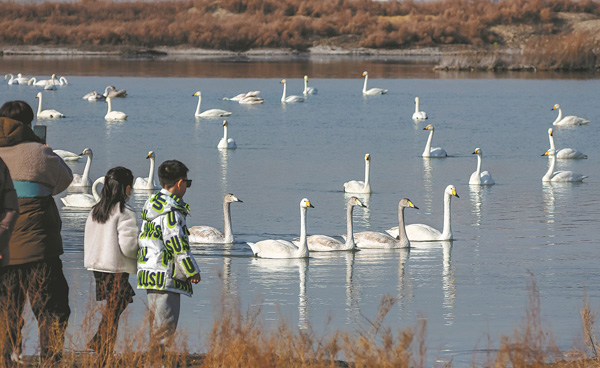Survey Points out Important Bird Wetlands

People watch wintering whooper swans at Yuncheng Salt Lake, a wetland area in the Yellow River Basin, in Yuncheng, Shanxi province, last month. YAN XIN/FOR CHINA DAILY
A total of 132 species of waterbirds were recorded last year in the Yellow River Basin, including 35 species under national protection and 19 species listed as globally threatened by the International Union for Conservation of Nature.
A total of 53 sites in the basin were identified as meeting the criteria for internationally important wetlands, with 13 of them in urgent need of effective protection measures.
These are part of the discoveries of the 2023 survey of waterbirds and their habitats in the Yellow River Basin released on Wednesday by the Institute of Geographic Sciences and Natural Resources Research of the Chinese Academy of Sciences and the Inner Mongolia Laoniu Charity Foundation in Beijing.
As one of the cradles of the Chinese civilization, the Yellow River Basin boasts many wetlands that lie on two bird migration routes: the East Asia-Australasia Flyway and the Central Asian Flyway, said Su Fenzhen, deputy director-general of the institute.
"These wetlands include offshore and coastal wetlands, rivers, lakes and marshes, serving as habitats for numerous rare and endangered waterbirds, such as the black-necked crane, the red-crowned crane, the Baer's pochard, the Relict gull and Saunders's gull," Su said at a news conference in Beijing. "They support the breeding, migrating and wintering of many migratory waterbirds, making the basin a critical region for the protection of migratory bird flyways in the country."
Professor Zhang Zhengwang from Beijing Normal University, who led the expert team in the survey, said that 285 people from 71 universities, research institutions, wetland conservation authorities and grassroots NGOs participated. Separated into 36 teams, they conducted five simultaneous bird counts at 78 survey sites along the Yellow River.
The bird counts covered 12 Ramsar sites (wetlands of international importance designated under the Ramsar Convention), 13 national reserves and many national wetland parks in the provinces of Qinghai, Sichuan, Gansu, Shanxi, Shaanxi, Henan and Shandong and the autonomous regions of Ningxia Hui and Inner Mongolia, he said. "The survey period spanned the complete life stages of spring, summer, autumn and winter."
Wendy Paulson, vice-chair of the Paulson Institute, which was one of the project's co-organizers, and chair of the Bobolink Foundation, said the status of waterbird populations and their habitats is a key indicator of the ecological health of the Yellow River Basin.
"That is why it is good to learn about the first-ever simultaneous surveys of waterbirds that have been conducted in the nine provinces (and autonomous regions) along the river basin," she said. "The results are informative and encouraging. These data will help to identify priority conservation areas, and they will also provide a baseline for measuring future conservation progress."
Yu Xiubo, the chief scientist of the survey and a researcher with the institute, presented the main findings of the survey at the news conference.
He said the survey recorded 132 species belonging to 10 orders and 21 families. Among these, 13 species are classified as first-level State protected birds, including the Oriental white stork, the black stork and the Siberian crane. Twenty-two species are under second-level State protection. And 19 species are globally threatened, including two critically endangered species, the Siberian crane and the Baer's pochard.
The survey also ranked the top 10 species by population for each season.
Out of the 78 survey sites in the Yellow River Basin, 53 met the criteria for internationally important wetlands, Yu said.
Several sites, previously not recognized as distribution areas of certain waterbird species, were identified by the survey as critical bird habitats, Yu said. The Qingtongxia Reservoir Area in Ningxia recorded 16,660 Eurasian coots, 32,110 grey herons and 3,445 great cormorants during the spring survey. In the Wuding River Basin in northern Shaanxi, 6,500 common cranes were counted during the spring survey. In Dongping Lake in Shandong, 650 Baer's pochards were sighted.
"Among 53 sites that meet the criteria for internationally important wetlands, only five had already been designated," he said. "The others still need to be put onto the List of Wetlands of International Importance. And 13 sites are unprotected areas at present and in urgent need of effective protection measures."
The researcher said the survey revealed the wetlands in the Yellow River Basin are diverse and face severe threats and challenges due to human activities and intensified climate change. It is necessary and urgent to undertake wetland protection and restoration work based on the degradation and characteristics of different wetland regions, he said.
Based on the survey data, the participating experts suggested enhancing the monitoring capacity for rare and endangered waterbirds and their habitats in the Yellow River Basin, and conducting specialized surveys to understand their population dynamics.
"Regular simultaneous surveys should be organized to expand the scope of the survey from the main stream of the Yellow River to the nine provinces and autonomous regions along its course," Yu said.
Rare and endangered waterbird species are more sensitive to environmental changes. So specialized surveys should be conducted for them throughout the entire basin to understand the distribution and population changes at different life stages, facilitating targeted conservation planning, he said.
Download attachments: